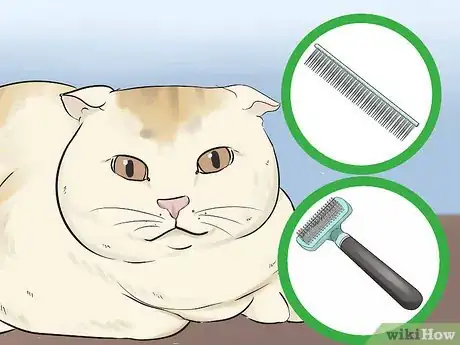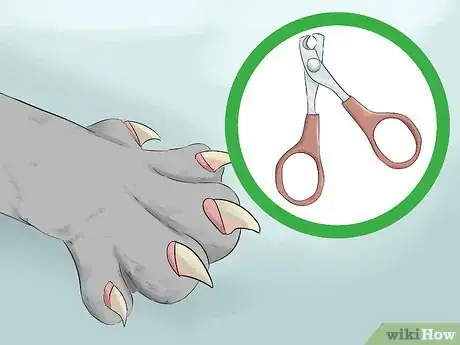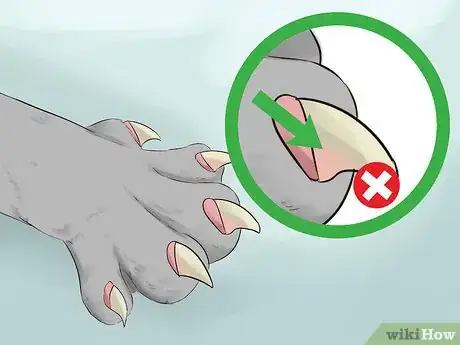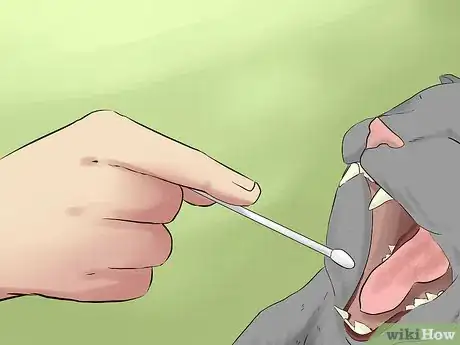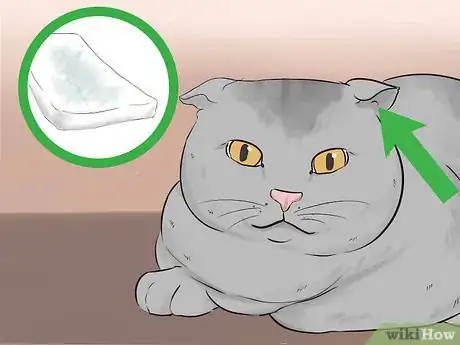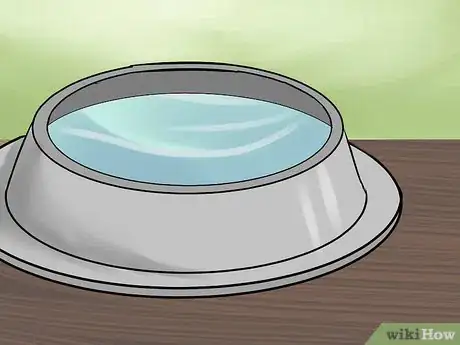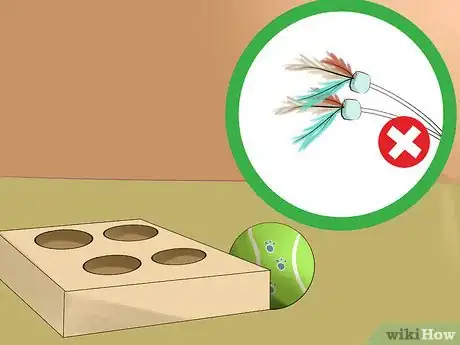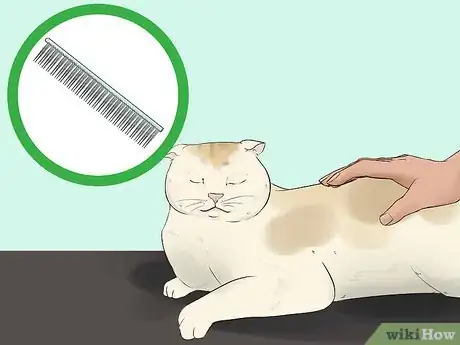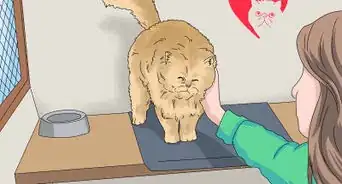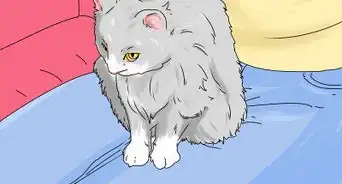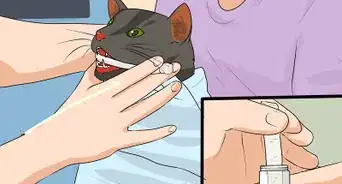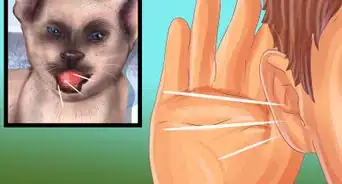This article was co-authored by Melissa Nelson, DVM, PhD. Dr. Nelson is a Veterinarian who specializes in Companion and Large Animal Medicine in Minnesota, where she has over 18 years of experience as a veterinarian in a rural clinic. She received her Doctor of Veterinary Medicine from the University of Minnesota in 1998.
There are 7 references cited in this article, which can be found at the bottom of the page.
This article has been viewed 26,967 times.
Meet your Scottish fold's basic needs by taking it to the vet for routine check ups, and by brushing its coat, cleaning its ears, and trimming its nails regularly. Make sure to choose a high-quality, brand name food, and try to avoid overfeeding your Scottish fold. Additionally, provide your cat with puzzle and teaser toys to keep it stimulated mentally and physically. Because Scottish folds are affectionate cats that love human interaction, make sure to interact with your cat for at least 30 minutes each day.
Steps
Keeping Your Cat Healthy and Clean
-
1Consult your vet. Take your cat to the veterinarian at least once a year for routine check ups and dental appointments. Also, make sure your cat is up-to-date with its shots and vaccinations.[1]
- Core vaccines (or vaccines that your cat must have) include panleukopenia (feline distemper), feline calici virus, feline herpes virus type I (rhinotracheitis), and rabies. Your vet may also suggest shots for feline leukemia virus, Bordetella, Chylamydophila felis, and feline immunodeficiency virus.[2]
- If your cat exhibits pain or stiffness in its tail or legs, then you should take your cat to the veterinarian. These are signs of a health issue common to Scottish folds called osteochondrodystrophy. This disease, which causes the Scottish Fold's distinctive ears, affects the cat's cartilage and can cause arthritis and bone deformities.[3]
- To optimize your cat’s health, ask your veterinarian about the Scottish fold’s nutritional, grooming, and health needs.
-
2Brush it regularly. If you have a shorthaired Scottish fold, then brush it once or twice a week using a metal comb. If you have a longhaired Scottish fold, then you will need to brush it daily. Use a wire slicker brush to comb your longhaired Scottish fold.[4]
- Brush in the direction of its hair growth and make sure to brush its whole body, including its chest and abdomen.
Advertisement -
3Acclimate your cat to nail trimming. If you decide to clip your cat’s nails yourself, then you will need to acclimate it to having its paws and nails handled. You can do this by:[5]
- Rubbing or massaging your cat’s paws and toes for two to three seconds a day.
- Pressing the pad to expose the nail for trimming. If your cat pulls away, wait until it is calm before handling its paws again. Reward it with treats and praise for good behavior.
- Using the nail clippers to clip a piece of macaroni near your cat’s ears as you handle its paws. The sound of the macaroni will familiarize your cat with the sound of its nails being clipped. Reward your cat with a treat and praise for good behavior.
-
4Clip its nails carefully. Clip the white part of the nail only. Do not clip near the pink part of your cat’s nails, also known as the quick. Because the quick contains nerves and blood vessels, it will bleed if you clip it. Keep a styptic stick or powder nearby just in case you clip the quick.[6]
- Trim only two or three nails at a time. Do this until your cat is comfortable with having its nails clipped. Remember to reward your cat with praise and treats for good behavior.
- Trim its nails every 10 to 14 days.
-
5Brush its teeth daily. If you cannot brush its teeth daily, then once or twice a week will suffice. Do not use human toothpaste to clean your cat’s teeth, as flouride and other ingredients in human toothpaste can make the cat sick. Purchase specially formulated toothpastes and toothbrushes from your local pet store. Clean your cat’s teeth by:
- Touching its teeth and gums with a Q-tip, or by gently massaging them with your finger. This will introduce your cat to the feeling of getting its teeth brushed. Practice this for a week.
- Placing a small amount of toothpaste onto your cat’s lips. This will introduce your cat to the taste of the toothpaste. Do this daily for a week.
- Pushing its lips back gently and touching the toothbrush to its teeth and gums. This will introduce the toothbrush to your cat. Practice this for a couple days. Reward your cat with praise and treats for good behavior.
- Gently scrubbing your cat’s teeth in a downward motion. You want to use a downward motion so you can remove plaque and tartar away from its teeth and gums. Do this once your cat is used to the toothpaste and toothbrush.
-
6Check its ears once a week. Check the outside of its ears for bald spots, and make sure the inner surfaces of its ears are light pink and clean. Check its ear canals by gently folding its ears back. The ear canal should be dirt-free, have a healthy pink color, and have minimal earwax.[7]
- If your cat’s ears look dirty, then use a damp cloth or cotton ball to wipe away dirt and debris. You can moisten the cloth with an equal parts water and apple-cider vinegar solution for a thorough clean. Never stick anything into your cat’s ears to clean them.
- If you notice swelling, a large amount of wax, bleeding, pus, or smell an odor, then you should take your cat to the vet to see if it has an ear infection.
-
7Make sure its litter box is clean. Check your cat’s litter box twice a day for cleanliness, i.e., once in the morning and once in the afternoon. Make sure to remove any waste and re-fill the litter box with fresh, clean litter.[8]
- Wash your cat’s litter box with hot water and a mild, unscented soap every two weeks. Do not use scented cleaning products (especially lemon-scented products) or cleaning products that contain ammonia or deodorants to clean your cat’s litter box.
Feeding Your Cat
-
1Feed it age-appropriate food. You will need to feed your Scottish fold kitten food when it is a kitten. Once it is one-year old, you may feed it regular, adult food.[9]
- Check the food’s label to make sure the food you have chosen is age-appropriate.
-
2Choose a high-quality, brand name food. Before purchasing a brand, make sure to check the ingredients list. The first two or three ingredients listed should be named meats like chicken, beef, salmon, or tuna, to name a few. If not, then choose a different brand.[10]
- You can feed your cat both wet and dry food. You can even mix its dry food with a little bit of wet food to make it more enticing.
-
3Do not overfeed it. You should feed your adult cat twice a day. However, how much you feed your cat depends on its activity level and health. Therefore, make sure to consult your veterinarian about your cat’s diet. Your veterinarian will be able to recommend a diet that is appropriate for your cat’s specific needs and lifestyle.
- Overfilling your cat’s food bowl may lead to obesity.
- Treats should make up no more than 5 to 10 percent of your cat’s diet.
-
4Provide it with fresh water daily. Change out your cat’s water bowl at least twice a day. This will guarantee that your cat has fresh water every day.[11]
- Make sure to rinse out its water bowl before refilling it if you see any dirt and debris.
- Rinse dirt and debris from its water bowl at least once a week.
Providing Mental and Physical Stimulation
-
1Provide it with a variety of toys. Because Scottish folds are intelligent, puzzle and teaser toys are a great choice. You can also keep your cat entertained with ping-pong balls, cardboard boxes, and crumpled pieces of paper. Make sure the toys you choose are safe and cat friendly.[12]
- Avoid toys that contain feathers, cords, strings, and ribbons, and toys that contain small pieces that can be chewed off and ingested. These toys may block the cat's digestive tract and seriously threaten the cat's life. Emergency treatment for swallowed strings can be expensive.
- Throw away and replace damaged toys.
-
2Play with it daily. Scottish folds love human interaction and they love to spend quality time with their humans. Therefore, provide your cat with daily attention and affection. You can do this by brushing or petting it, or by playing with it for at least 30 minutes a day.[13]
-
3Provide a companion. Scottish folds do not like being left alone. If you are gone most of the day because of work and other obligations, then you may need to get another cat to provide your Scottish fold with some company.[14]
- Because Scottish folds are dog-friendly cats, you could even get a dog to keep your cat company while you are away from home. Slowly introduce the cat and the dog to each other. Supervise them carefully for the first few weeks. This will help prevent fighting and injuries between them.
References
- ↑ http://www.humanesociety.org/animals/cats/tips/cat_care_essentials.html
- ↑ https://pets.webmd.com/cats/guide/cat-vaccinations#1
- ↑ http://www.vetstreet.com/cats/scottish-fold-highland-fold#health
- ↑ http://www.aspca.org/pet-care/cat-care/cat-grooming-tips
- ↑ http://www.aspca.org/pet-care/cat-care/cat-grooming-tips
- ↑ http://www.aspca.org/pet-care/cat-care/cat-grooming-tips
- ↑ http://www.aspca.org/pet-care/cat-care/cat-grooming-tips
- ↑ http://www.aspca.org/pet-care/cat-care/cat-grooming-tips
- ↑ http://www.aspca.org/pet-care/cat-care/cat-grooming-tips
- ↑ http://www.aspca.org/pet-care/cat-care/cat-grooming-tips
- ↑ http://www.aspca.org/pet-care/cat-care/cat-grooming-tips
- ↑ http://cattime.com/cat-breeds/scottish-fold-cats#/slide/1
- ↑ http://www.hillspet.com/en/us/cat-breeds/scottish-fold
- ↑ http://www.petful.com/cat-breeds/scottish-fold-cat-breed-profile/
About This Article
To care for your Scottish fold, give it highl quality cat food with meat, like chicken or beef, as its main ingredient. Feed your cat twice a day to prevent over-eating. If you have a short-haired Scottish fold, brush it once or twice a week. However, if it’s a long-haired cat, make sure to brush it every day to prevent debris from getting caught in its fur. You should also check its ears once a week for bald spots, swelling, or wax, which can indicate illness. Since Scottish folds are intelligent, provide your cat with interesting toys, such as puzzles, ping pong balls, or pieces of cardboard. For tips from our Veterinary co-author, including how to brush your cat’s teeth, read on!

